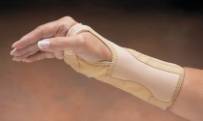Carpal Tunnel Syndrome
What is Carpal Tunnel Syndrome?
Carpel Tunnel Syndrome (CTS) is caused by pressure on the median nerve, (the main nerve into the hand), within a tunnel in the wrist. Symptoms may include tingling, numbness or pain in the hand and fingers. They may be worse at night and are relieved by shaking the hand over the side of the bed.
Why have I got Carpal Tunnel Syndrome?
The reason the nerve gets squashed as it passes through the wrist in some people is not known. It has an association with pregnancy, rheumatoid arthritis, thyroid diseases and diabetes, but having these conditions does not mean you will develop carpal tunnel syndrome. The diagnosis is usually clear, however in some patients the symptoms are equivocal and nerve conduction studies are needed. This is a test which measures how fast your nerves relay information up and down your arm- if it slows as it passes through the wrist then you have CTS.
 What are the non operative treatments?
What are the non operative treatments?
If your symptoms are mainly through the night then you may benefit from wearing a splint. The carpal tunnel is smaller when the wrist is bent and many people sleep with their hand in this position which why it occurs at night time. The splint is a removable glove which stops you wrist from bending while you sleep and can stop the onset of symptoms.
If tissue inflammation occurs in the carpal tunnel it will cause compression of the nerve. In these cases steroid injection can be helpful as hydrocortisone is a strong local anti-inflammatory. It can also be used in transient CTS which sometimes develop during pregnancy.
What is the operative treatment?
These symptoms can be cured by a small operation under local anaesthetic which frees up the nerve. Following the procedure your night tingling and pain should settle quickly but numbness in the fingers may take weeks or months to disappear.
The operation takes about 15 minutes under local anaesthetic which is injected into the wrist and may sting for a short while. A tight cuff is placed around the top of the arm acting as a tourniquet. This may be uncomfortable for a short while but allows the surgery to take place without bleeding. At the end of the operation the small cut will be stitched, and a dressing applied. The local anaesthetic will prevent any post operative pain but the hand and fingers may remain numb for about six hours after the surgery. Before this effect wears off you should take the painkillers that are prescribed for 24 hours.
Following the operation
- Keep the hand elevated at all times for the first 48 hours to prevent swelling and stiffness of the fingers. Please remember not to walk with your hand dangling, or to sit with your hand held in your lap.
- Continue to exercise the hand and to perform normal light activities.
- You will be discharged with a dressing which you should remove after 48 hours and reapply a clean plaster. There may be some swelling and bruising, however, if you are at all worried please contact your GP.
- Look out for any redness or tenderness in the area around the wound which might indicate an infection.
- After 10 days it is safe to get the hand wet.
- After 1 week you can drive as long as you are comfortable and have regained full finger movements.
- Your stitches will be removed 10 -14 days after the operation.
Complications
- You will have a scar on your palm. This will be firm to touch and possibly tender for up to 3-6 months. It nearly always settles with time and can be helped with massaging the scar.
- You may find your grip is slightly weak. This will gradually improve over the next 3-6 months.



